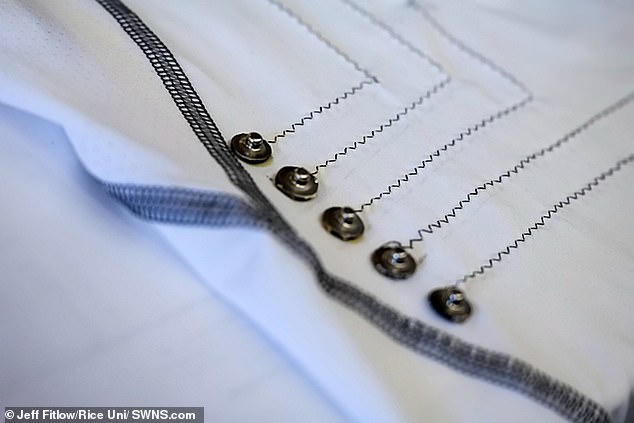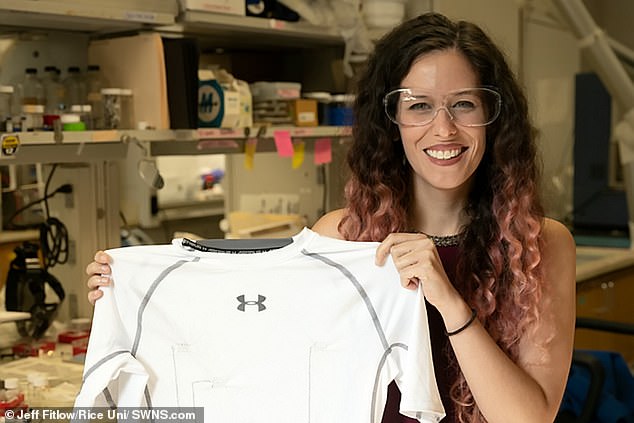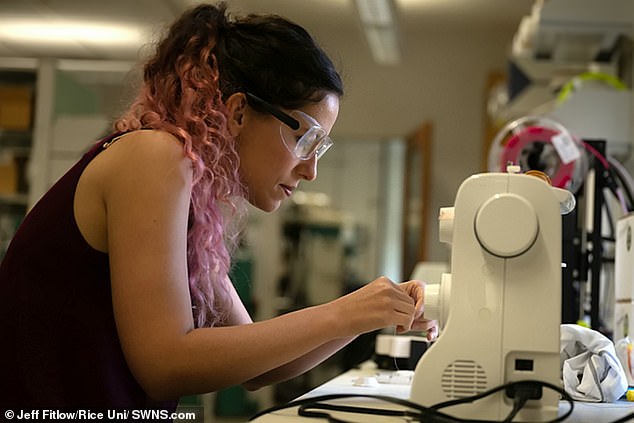Scientists claim to have the solution for health enthusiasts who don’t like to wear an ‘uncomfortable’ smartwatch.
The experts, based at Rice University in Texas, have created a machine-washable smart t-shirt that can monitor your heart.
They’ve sewn ultra-thin carbon nanotube fibres, which look just like threads of cotton, into normal athletic wear using a standard sewing machine.
The carbon nanotube monitors the wearer’s heart rate and takes a continual electrocardiogram (ECG), which captures a heart’s rhythm and electrical activity.

A machine-washable smart t-shirt that monitors your heart has been developed by scientists. It works by taking a continual electrocardiogram of the wearer and was proven in tests to give more accurate results than commercially sold chest-strap monitors
WHAT ARE CARBON NANOTUBES?
Carbon nanotubes, or CNTs, are cylindrical molecules that consist of rolled-up sheets of single-layer carbon atoms, or graphene.
CNTs have applications in flexible electronics, water filtration, antennas for 5G networks and energy storage.
Nanotube fibres are soft and flexible, and clothing that incorporates them is machine washable.
Advertisement
Fibres woven into fabric can also be used to embed antennas or LEDs, according to the researchers.
Minor modifications to the fibre could also eventually allow clothing to monitor vital signs, force exertion or respiratory rate.
‘Because of the combination of conductivity, good contact with the skin, biocompatibility and softness, carbon nanotube threads are a natural component for wearables,’ said engineer Matteo Pasquali at Rice University.
The fibres are just as conductive as metal wires, but washable, comfortable and far less likely to break when a body is in motion, according to the researchers.
In experiments, the shirt onto which they were sewn was better at gathering data than a standard chest-strap monitor taking live measurements.
Waves of the fibres can be sewn onto a piece of stretchable fabric in a zigzag formation to form an electrode, to connect electronics like Bluetooth transmitters to relay data to a smartphone.
The zigzag stitching pattern allows the fabric to stretch without breaking them.
ECGs obtained by the carbon nanotube fibres electrodes were comparable to signals obtained with commercial electrodes, according to the scientists.
When matched with commercial medical electrode monitors, the carbon nanotube shirt gave slightly better ECGs.

Rice University graduate student Lauren Taylor shows a shirt with carbon nanotube thread that provides constant monitoring of the wearer’s heart
The one proviso is the shirt onto which the fibres are sewn has to be tight-fitting and snug against the chest.
This means any loose-fitting t-shirt that billows up during a run would not work.
As long as it’s not too loose, the fibre’s zigzag pattern can be adjusted to account for how much a shirt or other fabric is likely to stretch.
The team now is working with the Texas Heart Institute to figure out how to maximise contact with the skin.
‘In future studies, we will focus on using denser patches of carbon nanotube threads so there’s more surface area to contact the skin,’ said Rice graduate student Lauren Taylor.

Taylor with a standard sewing machine, which can be used to sew the threads onto a tight-fitting garment
The project stems from work at the lab of chemical and biomolecular engineer Matteo Pasquali at Brown School of Engineering in Rhode Island, which introduced carbon nanotube fibere in 2013.
But the original nanotube filaments, at about 22 microns wide, were too thin for a sewing machine to handle.
Taylor said a rope-maker was used to create a sewable thread – essentially three bundles of seven filaments each, woven into a size roughly equivalent to regular thread.
‘We worked with somebody who sells little machines designed to make ropes for model ships,’ said Taylor, who at first tried to weave the thread by hand, with limited success. ‘He was able to make us a medium-scale device that does the same.’
The invention has been detailed further in the American Chemical Society’s journal Nano Letters.
SMART FABRICS VS E-FABRICS
Smart fabrics are fabrics that contain new or innovative components that benefit the wearer.
Smart fabrics, or smart textiles, can reacts to outside stimuli such as heat, chemicals or magnetism.
They do not necessarily have an electronic component.
The Pratt Institute in the US has said smart fabrics have the ability to ‘communicate, transform, conduct energy and even grow’.
Smart fabrics differ from e-fabrics (electronic fabrics), which generally combine fibres with electronics.
E-fabrics can contain lights, batteries or small computer chips.
Advertisement
Source link : https://www.dailymail.co.uk/sciencetech/article-9943237/Machine-washable-smart-t-shirt-monitor-heart.html











